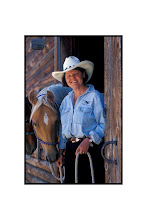“If horses
are your way of life, but injury-related back pain is limiting your
horseshoeing, then this is the book for you.”
I’m talking about Dr. Katie Cosgriff’s book, NO BACK … NO FARRIER. Seriously, you need to get your hands on this
book.
I
interviewed Katie the other day while she was shoeing our horses. The afternoon before arriving at my place she
had shod a half dozen draft horses. After she finished with six of ours, she was
headed to her next appointment. I ask
her, How to you do it? How can your body
hold up to this pace? She replied, “The
secrets are conditioning your core muscles, being mindful of your posture, and there’s
a lot of horsemanship and finesse that goes into it. It’s not about being stronger than the horse,
but you do need to have a strong back.”
 |
| 3 Generations of Cosgriffs hard at work!- Photo by Roni Ziemba |
And yes, it
helps to be following in the footsteps of her father, grandfather, and
great-grandfather—all Montana farriers. Katie
grew up on the family ranch north of Big Timber, Montana. She owned a tractor before she owned a
truck. From the time she was big enough
to pick up the shoeing tools she accompanied and helped her father and was soon
was shoeing side by side with him. Now
at age 37 she has been shoeing on her own for almost 20 years.
A graduate
of the MSU Farrier School, Dr. Katie Cosgriff, DC, CSCS, IVCA, holds an Animal
Science degree and a Human Biology degree from MSU-Bozeman, a Doctorate in
Chiropractic Medicine from the University of Western States in Portland,
Oregon, and is board certified by the International Veterinary Chiropractic
Association. She is a certified Strength
and Conditioning Specialist and teaches fitness classes in her “spare” time
around her shoeing schedule.
Katie is
what you would call a speed sport junkie.
Between being on the snowboarding team and riding as a jockey up and
down the West Coast she managed to injure both knees, tear up her shoulder and
damage her Achilles tendon. That was
before her crippling wreck on the race track ten years ago that left her unable
to walk and so weak (in her words) she “could not even pick up a pitch
fork.” It was a chiropractor that got
her back on her feet and fueled her passion to learn more about how the human
body can heal itself, and particularly to understand the biomechanics of the
foot and its impact on the entire body.
In her book,
she explains how it all fits together.
Farrier Science done correctly is a combination of disciplines. She explains how cross training keeps the
core muscles strong thus protecting the back.
How the foot/hoof affects the biomechanics of the ankle/pastern and the
joints all the way to the back. She
draws on her experience as a chiropractor as she analyzes form and function.
Katie’s book
was published almost a year ago. Within
the first year the readership has expanded and it is now recommended by both
the American and Canadian Professional Farriers Association. They give continuing education credits for
their members who read the book and successfully complete an exam. Recently her book No Back...No Farrier was
translated into German.
 |
| Photos by Roni Ziemba |
When I ask
her how many shoes she had tacked on in her career she grinned. Apparently she and her dad have been having
conversations about Norwegian persistence.
About the importance of being a life long learner and the joy it brings
them to share their knowledge. About her
passion for working on athletes, both 2-footed and 4-footed. About the importance of doing a job well and
how you need to protect your back if you are going to do your job for a long
time. Most recently they wondered how
big the stack would be if all the shoes that all four generations of Cosgriffs
have nailed on were piled up in one spot.
They decided it would weigh in the tons!
The answers
are all in her book. There are
delightful stories of family history and heritage in her book as well as down
to earth discussions on anatomy and pain referral patterns and exercises and
stretches. Get ahold of Katie if you
want a signed copy. For product preview and to order online go to www.lulu.com Again, that is No Back...No Farrier by Katie Cosgriff (Paperback) –online
at Lulu Marketplace.











